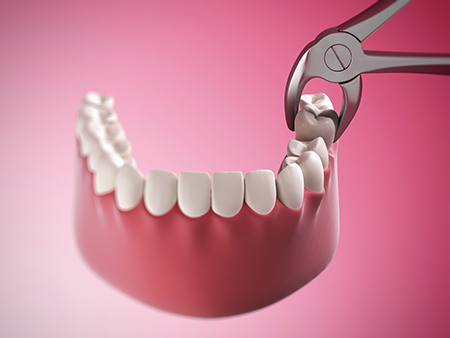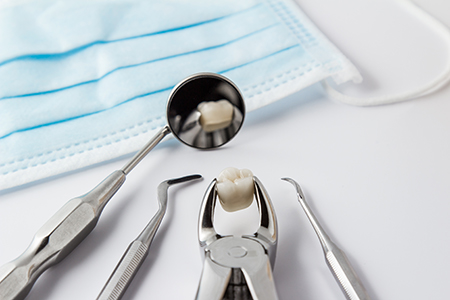
At the office of M. Kurt Berky, DDS, PC, we approach extractions with the same attention to detail and patient comfort that guide all our dental care. An extraction is never the first option we reach for — our goal is to preserve natural teeth whenever possible — but when removal is the safest or most predictable path, we perform the procedure with precision, clear communication, and thoughtful aftercare.
Deciding to remove a tooth can feel intimidating. We take time to explain why extraction is recommended, what to expect during the appointment, and how recovery typically progresses. That preparation helps reduce anxiety and allows you to participate in informed decisions about your oral health.
Our team blends years of clinical experience with modern diagnostic tools to evaluate each case. We’ll review medical history, current medications, and any special considerations so the procedure is planned to minimize risk and support a smooth recovery.
Retained or problematic baby teeth
Sometimes a deciduous (baby) tooth does not loosen as the adult tooth below it begins to erupt. If a baby tooth is severely decayed, ankylosed (fused to bone), or blocking normal development, removing it can protect the proper eruption and alignment of the permanent tooth.
Non-restorable decay in a permanent tooth
Tooth decay starts at the enamel and, if untreated, can progress through dentin to the nerve chamber. When structural damage is too extensive for a reliable restoration, extraction prevents ongoing infection and helps protect surrounding teeth and tissues.
Severe fractures that compromise the tooth
A tooth can fracture in many ways. When the break extends below the gumline, into the root, or leaves insufficient sound structure, extraction may be the most predictable way to prevent pain and infection and to plan appropriate replacement options.
Advanced periodontal disease
Significant gum disease can destroy the bone and soft tissues that hold teeth in place. When a tooth has lost its supporting structures and cannot be stabilized, extraction helps eliminate sources of infection and allows us to focus on restoring overall periodontal health.
Wisdom teeth that are impacted or causing problems
Third molars often lack the space to erupt normally, which can lead to impaction, recurrent decay, or damage to neighboring teeth. Removing troublesome wisdom teeth — particularly before they cause larger problems — is a common and frequently recommended choice.
Teeth removed as part of orthodontic planning
In some treatment plans, extracting carefully selected teeth creates the room necessary to align the remaining teeth and achieve a functional, stable bite. These decisions are coordinated with your orthodontist to support the best long-term result.

A successful extraction starts long before the instrument touches the tooth. We begin with a thorough review of your medical and dental history and take any appropriate radiographs to assess root shape, nearby anatomy, and bone structure. This evaluation determines whether a tooth can be removed simply or will require a more involved surgical approach.
We’ll discuss anesthesia and comfort options ahead of time. Most extractions are completed under local anesthesia, but for patients with anxiety or complex needs, additional sedation methods can be arranged and explained so you know what to expect during the visit.
Open communication is important: we review potential risks, short-term expectations, and the plan for follow-up care. If a surgical extraction is the safest choice, we coordinate with oral surgeons when indicated to ensure you receive the level of care best suited to the case.
When a tooth is visible in the mouth and the root anatomy is straightforward, it can often be removed with forceps after the area is numbed. Our attention to technique and gentle tissue handling helps limit trauma and supports a quicker recovery. We provide clear instructions on managing discomfort and what to expect in the first 24–72 hours.
Even with a simple extraction, we take steps to control bleeding, protect nearby structures, and make sure you feel comfortable throughout the appointment. If needed, we discuss restorative planning so you understand replacement options well before the site heals.
Teeth that are broken at the gumline, fused to bone, or impacted often require a surgical approach. This may involve a small incision, removal of a bit of bone, or sectioning the tooth so it can be removed safely. Local anesthesia is used in all cases, and additional sedation can be arranged for patient comfort when appropriate.
When a situation exceeds what can be safely performed in the office, we collaborate with an oral and maxillofacial surgeon. Referrals are made with your best interest in mind so you receive specialized care without delay.

Most people experience some swelling, mild discomfort, and light bleeding in the first day after an extraction. These are normal responses to tissue changes and usually respond well to simple measures: rest, cold packs for swelling, and appropriate pain relief. We’ll provide a tailored aftercare plan to reduce complications and support tissue healing.
Adhering to post-operative guidelines reduces the risk of problems such as infection or dry socket. We explain activity limits, diet recommendations, and oral hygiene steps so you can protect the clot that forms in the extraction site and allow the tissues below to repair.
If you have underlying medical conditions or take medications that influence clotting or healing, we coordinate with your physician as needed and provide specific instructions so recovery proceeds safely.
Maintain steady pressure on the site
A folded gauze pad placed over the socket and held in place by gentle biting encourages clot formation and controls initial bleeding. Change the gauze as instructed and avoid vigorous spitting or rinsing that might dislodge the clot.
Protect numb tissues
Do not chew, bite, or use the lip or tongue near the extraction while the local anesthetic is still active to prevent accidental injury.
Take medications as directed
If antibiotics are prescribed, complete the course as instructed. For pain control, take recommended analgesics on the schedule advised to stay ahead of discomfort; follow dosing guidance carefully.
Avoid actions that disturb healing
Do not rinse vigorously, spit forcefully, or use a straw for several days after the extraction. These actions can break the clot and prolong healing.
Use ice to manage swelling
Apply an ice pack to the outside of the face in short intervals during the first 24 hours to help reduce swelling. Warm compresses are typically introduced later if needed.
Avoid smoking
Smoking adversely affects clotting and tissue repair. Refrain from tobacco for at least the first week to lower the risk of complications.
Follow a gentle diet
Choose soft, cool foods for the first few days and avoid hot, spicy, or carbonated items. Stay well hydrated, but sip gently.
Keep oral hygiene cautious but consistent
Brush surrounding teeth carefully and, when appropriate, use a mild saltwater rinse to keep the mouth clean. Avoid vigorous rinsing in the first 24–48 hours.
Attend follow-up appointments
If sutures were placed or additional monitoring is needed, please keep the scheduled follow-up so we can confirm proper healing and address any questions.
Contact our office if you experience persistent bleeding, worsening pain, rising fever, or any other signs that feel unusual. Prompt communication helps us intervene early if complications arise.

Removing a tooth can be a step toward improved oral health, but it often raises questions about replacing the missing tooth. Restoration choices depend on the location of the tooth, the health of adjacent teeth, bone levels, and your long-term goals for function and appearance.
Common replacement options include removable dentures, fixed dental bridges, and dental implants. Each approach has different clinical implications: they vary in how they preserve adjacent teeth, support jawbone health, and restore chewing function. We’ll discuss the advantages and considerations for each so you can make an informed choice.
If you are considering implants, we evaluate bone quality and quantity and may recommend grafting when necessary to create a stable foundation. When a bridge is chosen, we plan tooth preparation to maximize longevity while preserving as much natural tooth as possible.
We combine decades of clinical experience with modern diagnostics and gentle techniques to deliver predictable, patient-centered extraction care. Our team focuses on clear communication, careful planning, and individualized aftercare so each patient understands the process and recovery path.
When treatment requires coordination — for example, with an oral surgeon or with restorative planning for implants or bridges — we manage those referrals and discussions to keep care seamless and focused on your best outcome.
Your comfort matters: from procedural options to recovery instructions, we tailor each plan to your needs and preferences to help make the experience as smooth as possible.
To learn more about tooth extractions, your treatment options, or to discuss a specific situation, please contact us for more information and to schedule a consultation.

The most common reasons for tooth loss include advanced periodontal disease, extensive tooth decay, and facial trauma. According to statistics, gum disease is responsible for close to 70% of tooth loss in adults. Although less frequent than the preceding three reasons, it should also be noted that specific diseases, drugs, smoking, and poor nutrition contribute to the risk of tooth loss.
The Centers for Disease Control and Prevention report that in the United States, an average of 12 teeth (including the wisdom teeth) are lost by the age of 50. Also, 26% of adults between 65 and 74 years of age have lost all their teeth.
Every patient and every situation is different. However, when a tooth and the surrounding tissues are numbed with a local anesthetic, you should only expect to feel a bit of pressure, but no pain as the tooth is being loosened from the surrounding tissues and extracted. For patients who are apprehensive and for some surgical extractions, our office will discuss our options in dental sedation to provide further relaxation and reduce any sense of discomfort.
While it's normal to feel some tenderness and swelling following an extraction, the degree of these sensations can vary. It mostly depends on the complexity of the extraction and the body's response to the procedure. We'll recommend or prescribe the appropriate pain medication to help ensure your comfort and give you specific instructions for maximum effectiveness and safety.
Typically, the recovery period following a simple extraction is shorter than a surgical extraction. However, a patient's overall health, habits, the size and location of the tooth, and other variables can influence recovery and healing. To speed up the recovery and avoid any complications, patients must follow the given at-home instructions diligently. We'll carefully review what to expect following your procedure and go over your post-op instructions.
Smoking interferes with blood clot formation, which is an essential first step in the healing process. Blood clot formation not only provides a protective layer to cover the underlying exposed bone and nerve endings, but it also supports the growth of new tissue. Cigarette smoke also contains chemical toxins that can disrupt the healing process and lead to problems such as continued inflammation, infection, or dry socket.
In a very small percentage of cases, a condition known as dry socket can develop in the aftermath of a dental extraction. This painful condition can arise when the blood clot in the extraction site doesn't form properly or gets dislodged. With dry socket, you may experience throbbing pain and symptoms such as bad breath and an unpleasant taste in your mouth. As skilled providers of care, our office will provide immediate treatment to alleviate your discomfort and promote healing.
The last teeth in your mouth to develop, wisdom teeth often do not have enough room to fully erupt or may be positioned in the wrong direction. These issues can affect your dental health as well as overall wellbeing. While some individuals never develop all their wisdom teeth, and a few have sufficient space for them, there are many people with partially or fully impacted third molars. Our office will monitor the development, position, and health of your wisdom teeth and will advise you if and when extractions are indicated.
After a tooth is removed, bone-grafting material is sometimes placed in the socket to promote healing and encourage new bone development. This procedure is often performed to support the eventual and successful placement of a dental implant.
At the office of M. Kurt Berky, DDS, PC, we strive to make dental care affordable and accessible. Depending on the type or complexity of the extraction and other variables, the cost of the procedure can vary. Based on our diagnostic findings, our office will inform you of the healthiest choices in care, explain the fees, discuss insurance coverage, and explain your payment options.
Many dental plans offer some level of coverage for tooth extractions. We'll advise you if your plan covers the full cost of the procedure and if there is any out-of-pocket expense. Our business office will work with you to maximize your insurance benefits as much as possible while helping you minimize any out-of-pocket expenses.
A tooth extraction is the removal of a tooth from its socket in the jaw. Dentists recommend extractions when a tooth cannot be saved or when it poses a risk to adjacent teeth or overall oral health. The primary goals are to eliminate pain, stop the spread of infection, and protect surrounding tissues.
Decisions about extractions are based on a clinical exam, dental radiographs such as digital X-rays or CBCT scans, and a review of your medical history. We discuss alternatives when appropriate and explain the type of extraction likely needed as well as any preoperative precautions. Patient input and clear communication help determine the best course of care and the next steps following extraction.
Common reasons for extraction include severe decay that leaves a tooth non-restorable, a cracked or fractured tooth that cannot be repaired, advanced periodontal disease that has compromised supporting bone, and impacted or problematic wisdom teeth. Pediatric patients may need removal of an over-retained baby tooth that blocks eruption of the permanent tooth. Extractions can also be part of orthodontic plans when overcrowding prevents proper alignment.
Each situation is evaluated individually to determine whether alternatives such as root canal therapy, periodontal treatment, or restorative procedures are feasible. When extraction is the safest option, we explain how removing the tooth will protect oral function and reduce the risk of further complications. We also review timing and follow-up care to support optimal healing.
A simple extraction is performed when the tooth is fully visible in the mouth and can be removed with forceps after the area is numb. This procedure generally involves loosening the tooth, applying controlled force, and removing it with minimal incision or bone removal. Simple extractions are commonly performed in the dental office under local anesthesia.
Surgical extractions are indicated when a tooth is broken below the gumline, ankylosed, severely impacted, or when root anatomy makes removal more complex. Surgical procedures may require a small incision, removal of a bit of bone, or sectioning of the tooth for safe extraction, and they are sometimes performed by an oral surgeon. We will explain whether a referral is recommended and review sedation or anesthesia options for comfort and safety.
For most extractions we use local anesthesia to thoroughly numb the tooth and surrounding tissues, ensuring you feel little to no pain during the procedure. Many patients also benefit from additional options such as nitrous oxide (laughing gas) or oral sedation to reduce anxiety and promote relaxation. We discuss these choices in advance and tailor the approach to each patient’s needs and medical history.
For more complex surgical extractions or when extensive sedation is required, procedures may be coordinated with an oral surgeon who can provide IV sedation or general anesthesia in an appropriate facility. Your medical history, current medications, and any health conditions will guide the safest anesthesia plan. Clear preoperative instructions are provided to ensure the chosen sedation is managed safely.
Before your extraction, we will review your medical history, current medications, and any allergies to determine if special precautions are needed. If you take blood-thinning medications or have a condition that affects healing, we coordinate with your physician when necessary and provide specific preoperative guidance. Follow any instructions about fasting if sedation is planned and arrange for a responsible adult to accompany you and drive you home when required.
It is helpful to wear comfortable clothing and to bring a list of medications and medical contacts to your appointment. We may prescribe antibiotics or recommend adjustments to certain medications in advance when indicated by your health status. Preparing your home with soft foods and supplies such as gauze, ice packs, and over-the-counter pain relievers can help streamline recovery after the procedure.
Initial healing typically begins within the first 24 to 72 hours, when a blood clot forms at the extraction site and swelling peaks and then gradually subsides. You will be asked to maintain gentle pressure with gauze to control bleeding, avoid rinsing vigorously, and refrain from using straws or smoking to protect the clot. Applying ice intermittently, eating soft foods, and resting for the first day help minimize discomfort and swelling.
Over the following week you should notice steady improvement in pain and function, while complete soft tissue healing continues for several weeks. Maintain gentle oral hygiene and follow any instructions about using warm saltwater rinses after the first 24 hours. Keep scheduled follow-up appointments so we can monitor healing and remove sutures if needed.
Most extractions heal without issue, but complications can include prolonged bleeding, infection, or a painful condition known as dry socket when the clot is dislodged. Signs of infection include persistent swelling, fever, worsening pain, or pus drainage, while dry socket typically causes increasing intense pain a few days after extraction and may radiate to the ear. Risk factors for complications include smoking, poor oral hygiene, and certain systemic health conditions.
If complications occur, prompt evaluation allows us to provide targeted treatment such as medicated dressings for dry socket, antibiotics for infection, or additional measures to control bleeding. We give clear instructions on when to contact the office and how to manage symptoms at home, and we coordinate care with specialists when more advanced intervention is needed. Early communication helps reduce the chance of prolonged problems and supports faster recovery.
Contact the office promptly if you experience heavy bleeding that soaks through gauze after several hours, severe pain not controlled by prescribed medications, or signs of infection such as fever and increasing swelling. You should also call if you develop persistent numbness, a bad taste or odor that does not improve, or any allergic reaction to medications. Timely communication allows us to assess symptoms and provide appropriate care.
We provide post-operative instructions that outline expected symptoms and emergency contacts for after-hours concerns. If you are unsure whether a symptom is normal, it is better to call and have us evaluate the situation than to wait. Quick intervention can prevent minor issues from becoming more serious.
Yes — a missing tooth can often be replaced, and common options include removable dentures, fixed bridges, and dental implants. Dentures and bridges restore function and appearance, while dental implants replace the tooth root and offer a stable, long-term solution that closely mimics natural teeth. The best choice depends on factors such as the location of the missing tooth, bone volume, overall oral health, and patient preferences.
Timing for replacement varies; some patients are candidates for immediate replacement, while others require a healing period or bone grafting before implant placement. We discuss the benefits and clinical considerations of each option during your follow-up and develop a personalized treatment plan that addresses both function and aesthetics. Collaboration with specialists is arranged when a complex restorative plan is required.
The office of M. Kurt Berky, DDS, PC combines years of clinical experience with modern diagnostic tools such as digital radiography and CBCT imaging to plan extractions precisely and safely. Dr. Berky’s background and ongoing training in advanced dentistry support treatment approaches that emphasize patient comfort, proper diagnosis, and coordinated care. When complex surgical removal is needed, we work closely with oral surgeons to ensure the best outcome.
We prioritize clear communication about the procedure, anesthesia options, and post-operative care to help patients feel informed and prepared. Personalized follow-up and collaboration with a patient’s medical providers when appropriate help support safe healing and the most appropriate restoration plan after extraction. Our approach is focused on predictable results, patient safety, and long-term oral health.

Have questions or need to book your next appointment?
Our friendly staff at M. Kurt Berky, DDS, PC is ready to assist. Whether by phone or our online contact form, contacting us is simple and convenient. Start your journey to a healthier, brighter smile today by reaching out to our office.